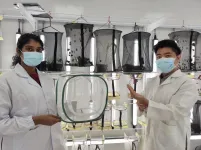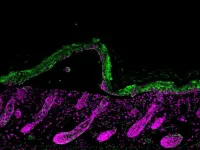A new model of Alzheimer's progression
2021-06-14
(Press-News.org) Alzheimer's disease is the most common form of dementia and is characterized by neurodegeneration in regions of the brain involved in memory and learning. Amyloid beta and tau are two toxic proteins that build up in disease and cause eventual neuronal death, but little is known about how other cells in the brain react during disease progression.
A new study from the ASU-Banner Neurodegenerative Research Center (NDRC) and MIT/Koch Institute sheds new light on how disease processes manifest in patients with Alzheimer's disease.
Diego Mastroeni of the NDRC teamed up Forest White and Douglas Lauffenburger, colleagues in MIT's Department of Biological Engineering, to explore how protein and signaling pathways change in patients with Alzheimer's disease. Their analysis captures a detailed molecular profile of changes in protein levels and alterations known as protein phosphorylation across a cohort of patients with well-preserved brain tissue, from the Banner Sun Health Research Institute. Their work creates a new model of disease progression, taking advantage of the heterogeneity that is inherent to human studies.
"This manuscript highlights the importance of integrating the phosphoproteome with the proteome and transcriptome datasets to get a better picture of the drivers of disease, from transcription to translation," said Mastroeni. (The phosphoproteome refers to proteins that have undergone epigenetic modification through the addition of a phosphate group. The proteome incudes the full complement of all proteins in the body, while the transcriptome refers to the RNA messages produced by genes, which are subsequently translated into proteins.)
The researchers' analysis highlights the links between toxic protein build-up, neurodegeneration, and the glial cells which support and protect neurons in the brain. In particular, they found an intriguing association between markers of neurodegeneration and two types of glial cell: oligodendrocytes and microglia. Progressive alterations in these cells may be key to understanding the causes of neurodegeneration.
The new study appears in the journal Nature Aging.
"Our results show that there are a plethora of cellular signaling pathways that are activated at all stages of disease. We may be able to repurpose available therapies to target protein kinases that regulate these cell signaling events," White says. "Clinicians today are studying therapeutic effects on amyloid and tau as proxies for disease, but our results suggest that glia cells are involved at every step of the process. Improved understanding of glia cells and their roles in progressive neurodegeneration may provide new opportunities for treatment of this disease."
"This collaborative effort is the kind of work that we at the NDRC value," Mastroeni says. "No one individual can tackle this disease on their own; it's going to take a group effort to combat this devastating illness."
INFORMATION:
[Attachments] See images for this press release:

ELSE PRESS RELEASES FROM THIS DATE:
2021-06-14
Osaka, Japan - Researchers from the Graduate School of Engineering and the Center for Quantum Information and Quantum Biology at Osaka University unveiled a new solid state second-harmonic generation (SHG) device that converts infrared radiation into blue light. This work may lead to a practical daily-use deep ultraviolet light source for sterilization and disinfection.
Recently, deep ultraviolet (DUV) light sources have been attracting much attention in sterilization and disinfection. In order to realize a bactericidal effect while ensuring user safety, a wavelength range of 220-230 nm is desirable. ...
2021-06-14
Singapore, 14 June 2021 - Many butterfly species bear distinct circular markings known as eyespots on their wings, and the functions of these rings of contrasting colours vary. A long-standing theory is that they serve as anti-predator defences - small eyespots along the wing margin can protect butterflies by directing predators to attack less important parts of the body, such as the hindwings, enabling them to escape.
Most nymphalid family butterflies have half as many eyespots on their forewings compared to their hindwings. In particular, this has been observed in the bush brown butterfly Bicyclus anynana.
A recent research by biologists from the National University of Singapore (NUS) sought to understand the impact of uneven distribution of eyespots. ...
2021-06-14
A team of scientists has shown that the healing of skin blisters is driven by hair follicle stem cells, which delay their own development in the process.
The healing process of the tissues in the human body is particularly well-studied in skin, especially as skin serves as a layer of protection from the environment. However, there remain some specific types of skin injuries where the healing process is not well understood.
A team of scientists from Japan and Italy, including Associate Professor Ken Natsuga from the Graduate School of Medicine at Hokkaido University, have used models of skin blisters to explore the effects of injury on developing skin tissue. Their discoveries ...
2021-06-14
Nearly 12,000 people in Sweden received sickness benefit from the Swedish Social Insurance Agency for COVID-19 during the first wave of the pandemic. The median duration of sick leave in this group was 35 days, but for many it was considerably more long-drawn-out, according to a University of Gothenburg study.
A research group in rehabilitation medicine at the University of Gothenburg has studied sick-leave patterns. The study now presented in the scientific journal BMC Public Health.
The study included all recipients of sickness benefit from the Social Insurance Agency for COVID-19 diagnoses in Sweden during the first pandemic wave, from 1 March to 31 August 2020, and monitored them for 4 months from the start of ...
2021-06-14
Artemisone is a promising substance in the fight against malaria. However, the active ingredient has yet to be used due its instability and because it is not easily absorbed by the body. A team from Martin Luther University Halle-Wittenberg (MLU) and the Hebrew University of Jerusalem has now pushed this a bit further. They have developed a very simple method for preparing the active ingredient that makes it easier to administer and store. The researchers report on their work in the scientific journal "Antimicrobial Agents and Chemotherapy".
Malaria is caused ...
2021-06-14
High running capacity is associated with health and longevity. However, whether high genetic running capacity promotes more efficient metabolism with aging is not known. A new study conducted in collaboration between the universities of Shanghai Jiao Tong University (China) and Jyväskylä (Finland) investigated the effects of genetic running capacity and aging on tissue metabolism. The study reveals that adipose tissue may have a key role in healthy aging.
Running capacity, expressed as aerobic capacity, refers to an individual's capacity to utilize oxygen and is known to decrease with age, thereby affecting the whole body metabolism and health.
"We currently lack the information ...
2021-06-14
A team of neuroscientists are calling for greater support of neuroscience research in Africa following a long-term analysis of research outputs in the continent.
The findings detail important information about funding and international collaboration comparing activity in the continent to the US, UK and areas of Europe. It's hoped that the study will provide useful data to help shape and grow science in Africa.
Africa has the world's largest human genetic diversity which carries important implications for understanding human diseases, including neurological disorders.
Co-lead ...
2021-06-14
Hurricanes that make landfall typically decay but sometimes transition into extratropical cyclones and re-intensify, causing widespread damage to inland communities
The presence of a cold core is currently used to identify this transition, but a new study has now found that a cold core naturally forms in all landfalling hurricanes
The cold core was detected when scientists ran simulations of landfalling hurricanes that accounted for moisture stored within the cyclone
Over time, the scientists saw a cold core growing from the bottom of the hurricane, replacing the warm core
The research could help forecasters make more ...
2021-06-14
A study led by University of Minnesota Twin Cities researchers uncovered a property of magnetic materials that will allow engineers to develop more efficient spintronic devices in the future. Spintronics focuses on using the magnetic "spin" property of electrons instead of their charge, which improves the speed and efficiency of devices used for computing and data storage.
The research is published in Physical Review B, a peer-reviewed scientific journal published by the American Physical Society.
One of the major roadblocks in developing better spintronic devices is an effect called "damping," in which the magnetic energy essentially leaks out of the materials, causing them to be less efficient. Traditionally, scientists ...
2021-06-14
Humans often cooperate, but ample research has shown that they're conditionally cooperative; that is, they are far more likely to cooperate with those who they consider "good."
In large societies, however, people don't always know the reputations of the people with whom they interact. That's where reputation monitoring systems--such as the star ratings for eBay sellers or the scores assigned by credit bureaus--come into play, helping guide people's decisions about whether or not they want to help or interact with another person.
In a new paper in the journal Nature Communications, a team from Penn uses mathematical modeling to study how public institutions of reputation monitoring can foster cooperation and also encourage participants to adhere to its assessments instead ...
LAST 30 PRESS RELEASES:
[Press-News.org] A new model of Alzheimer's progression






